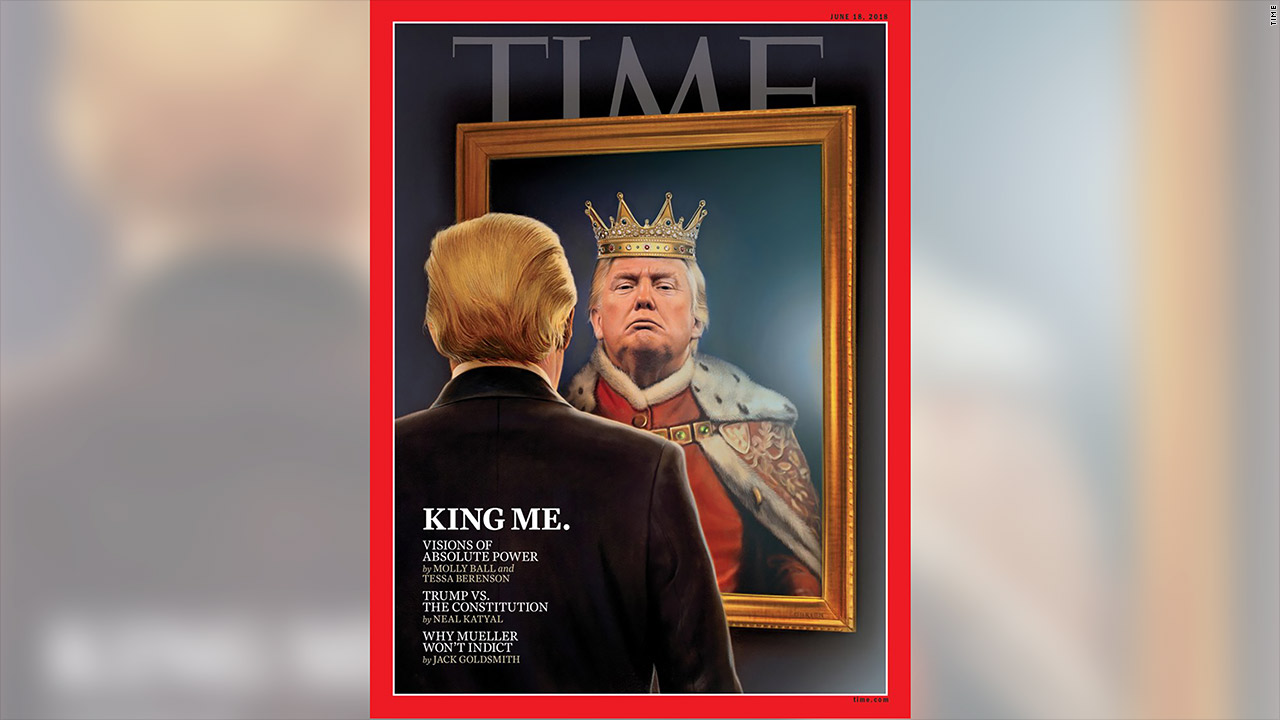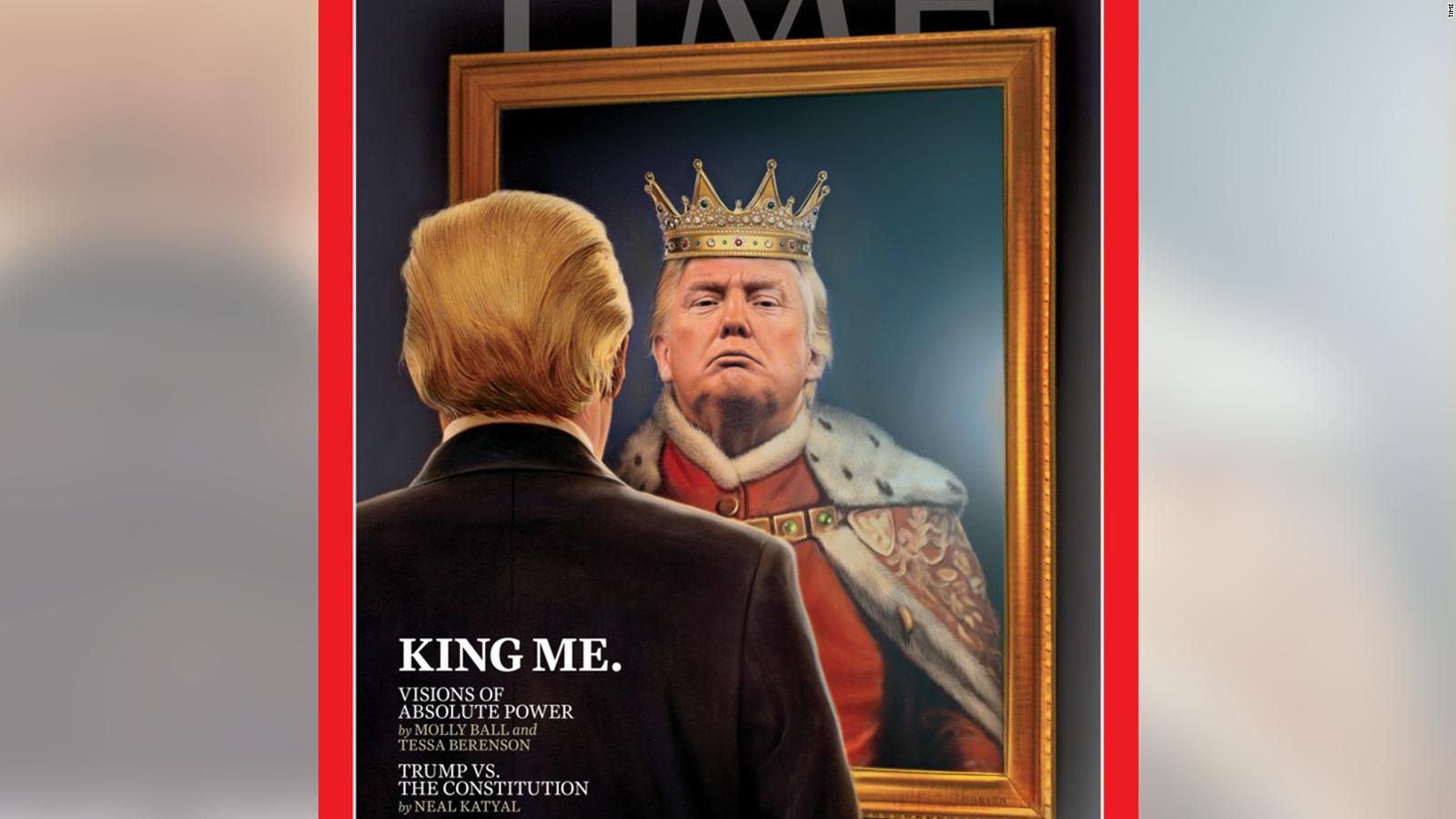Trump "King" Cover: White House Trolls With Fake Time Magazine - Latest
Did a carefully orchestrated digital spectacle, complete with regal imagery and audacious pronouncements, signal a shift in the narrative surrounding a former president? The White House, in a move that has ignited both controversy and fervent discussion, unleashed a series of provocative images and statements that centered around one figure: Donald Trump.
The genesis of this saga can be traced back to a post, disseminated across various social media platforms, including Instagram and X (formerly Twitter). This wasn't just a fleeting online update; it was a deliberate escalation, a theatrical flourish designed to capture attention and, perhaps, redefine perception. The visual centerpiece was an illustration of Mr. Trump, resplendent in a crown, gracing the cover of a magazine. The magazine's design mimicked the iconic style of "Time," but with a crucial alteration: its title was replaced with the name "Trump."
The White House didn't stop there. The message was further amplified, the digital echo reverberating across the online landscape. A parody cover of "Time" magazine was shared on the official X account. This wasn't a subtle hint or a veiled suggestion. The message was direct, bold, and impossible to ignore: a cover showcasing Trump wearing a crown, accompanied by the headline, "Long live the King." This declarative statement, in its simplicity, encapsulated the entire operation's audacious premise.
The timing of these posts, and the specific messaging employed, offered a compelling glimpse into the strategies employed by those seeking to shape public opinion. Wednesday, February 19, 2025, marked the day the White House decided to troll President Donald Trump's detractors, posting a parody of a time cover hailing him as a king and wearing a crown. Simultaneously, on platforms like Truth Social, Trump himself echoed the sentiment, sharing the "Long live the King!" proclamation. His statement was then amplified again, this time through the official White House X account, alongside an illustrated picture reminiscent of a "Time" magazine cover.
| Category | Details |
|---|---|
| Full Name | Donald John Trump |
| Date of Birth | June 14, 1946 |
| Place of Birth | Queens, New York City, New York, U.S. |
| Education | Fordham University (attended 1964-1966), University of Pennsylvania (B.S. in Economics, 1968) |
| Political Affiliation | Republican |
| Political Positions | Former U.S. President (2017-2021) |
| Profession | Businessman, Television Personality, Author |
| Notable Achievements | Real estate developer, Owner of the Miss Universe Organization, Host of "The Apprentice," 45th President of the United States |
| Personal Interests | Golf, Business, Media |
| Link to Biography | Official White House Biography |
The White House didn't rely solely on repurposed content or subtle insinuations. On its official Instagram account, another layer was added to the narrative. There was the introduction of AI-generated images of President Trump, adorned with a crown, further solidifying the image of regal authority. On Thursday, February 20, 2025, a statement was released, coupled with another AI-generated imagethis time, a fake "Time" magazine cover. The implication was clear: the narrative was being carefully crafted, layer upon layer, in the digital space.
This wasn't a spontaneous act, a one-off occurrence. The origins of the "Long live the King!" proclamation can be traced back further. In the preceding week, Trump himself had posted a fabricated "Time" magazine cover. He was portrayed wearing a crown, a smug grin playing across his face, accompanied by the same bold proclamation. This act, in itself, was a statement. It invited interpretation, sparking discussions among his supporters, and fueling the controversy.
The core question, however, remains: what was the intent behind this orchestrated display of digital artistry? Was it designed to solidify support, to provoke a reaction from detractors, or perhaps to cultivate a particular perception of power and authority? The answer, likely, is a combination of these factors. The visual language employedthe crown, the formal attire, the manipulation of iconic imageryspeaks volumes about the desired effect.
The choice of "Time" magazine as a source of inspiration was particularly significant. The publication, a global arbiter of influence, is renowned for its "Person of the Year" designation. Trump's name has, in the past, been associated with this honor. But the use of a parody, the substitution of the magazine's name with "Trump," suggests a deliberate subversion of the established order, a playful gesture intended to provoke and perhaps, reclaim control of the narrative.
The reaction to these online pronouncements was swift and impassioned. Critics of the former president were quick to voice their outrage. The White House's actions were labeled as controversial, sparking widespread condemnation. The sharing of a fake magazine cover with Trump wearing a crown and the "Long live the King" slogan was seen as a direct affront to democratic values and a disturbing attempt to portray Trump in a monarchical light.
Yet, the response wasn't uniform. Supporters of Trump were more inclined to chuckle. Some saw the imagery as playful, a clever jab at his detractors. Others might have interpreted the actions as a bold assertion of strength, a signal of dominance in the face of opposition. The "Long live the King" slogan might have resonated, reinforcing their belief in his leadership.
This digital spectacle didn't exist in isolation. It was interwoven with the broader socio-political context of the time. The reference to Manhattan and all of New York being "saved" could be interpreted as a nod to Trump's past business interests in the city and potentially to the promises he made during his political campaigns. The inclusion of images featuring iconic New York buildings in the backdrop served to solidify the visual connection. The consistent use of familiar fonts and design elements, particularly those of "Time" magazine, was a conscious effort to blur the lines between reality and fiction, adding a layer of intrigue to the entire operation.
The incident also illustrates the increasing reliance on artificial intelligence and digital tools in political communication. The production of AI-generated images, in this case, served a specific purpose: to create visuals that enhanced the desired narrative. The image wasn't merely an image; it was a message. The careful selection of clothing, the regal crown, the confident expression all served to convey a certain message. These weren't accidental choices; they were deliberate elements of a planned digital campaign.
This particular event also highlights the role of social media in shaping the political landscape. Platforms such as X (formerly Twitter) and Instagram provided the perfect avenues for the dissemination of these carefully constructed images and messages. The speed and reach of these platforms ensured that the content spread rapidly, reaching a vast audience in a matter of moments. The social media echo chamber also allowed Trump and his team to communicate directly with their supporters, bypassing the traditional media and cultivating their own version of reality.
In the end, the episode, whether a tactical blunder or a deliberate play, serves as a case study in political communication in the 21st century. It underscores the power of visual imagery, the influence of social media, and the importance of narrative in shaping public perception. It invites a wider discussion about the boundaries of political discourse and the ongoing erosion of the line between fact and fiction in the digital age.
The ongoing discussion surrounding whether Trump would again be named "Time" magazine's "Person of the Year" also plays a crucial role in the context of the story. This adds a layer of historical importance to the narrative. If Trump was indeed slated to be named "Person of the Year" for the second time, it would solidify his influence and prestige. The White House's move could then be seen as either a preemptive move, an attempt to shape the perception surrounding this honor, or a commentary on the publication's role in shaping public opinion.
This orchestrated online display, with its crowns, pronouncements, and carefully curated visuals, offered a unique snapshot of the current political and digital landscape. It posed questions about power, perception, and the ever-evolving ways in which narratives are constructed and disseminated in the 21st century. The ripple effects of this digital episode are likely to be felt far beyond the platforms on which they were initially shared.


